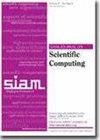无矩阵精确牛顿法
IF 2.6
2区 数学
Q1 MATHEMATICS, APPLIED
引用次数: 0
摘要
SIAM 科学计算期刊》,第 46 卷第 3 期,第 A1423-A1440 页,2024 年 6 月。 摘要。介绍了求解[数学]非线性方程组的牛顿方法的一种改进。与一系列不精确的牛顿方法相比,新的无矩阵方法是精确的,即计算线性牛顿系统的雅各布因子和解时无需截断。它依赖于根据微分链规则将残差的结构密集可逆雅各布分解为[数学]结构稀疏可逆元素雅各布的乘积。受算法微分的邻接模式启发,避免了残差雅各布的显式累积。新方法的前瞻性、普遍适用性实施可以基于类似的想法。利用稀疏性直接求解线性牛顿系统。对稀疏性的优化利用会产生稀疏线性代数中各种著名的难以计算的组合优化问题,如带宽或定向消除排序。该方法是在分解为带宽[数学]为[数学]的元素雅各比的背景下提出的。在[math]的可能情况下,标准牛顿算法的计算成本主要是累积残差雅各布的成本。它可以估计为 [math],因此超过了直接求解线性牛顿系统的 [math] 成本。新方法将这一成本降低到[math],可能提高[math]倍。针对三对角线情况的运行时间测量结果表明,计算成本降低了[math]。推广后,我们得到了无矩阵精确牛顿步问题。我们证明了 NP 的完备性,并介绍了构建近似解方法的算法组件。无矩阵精确牛顿法在计算成本高昂的非线性残差代理的机器学习中的潜在应用,将作为得出的各种结论的一部分简要介绍。本文章由计算机程序翻译,如有差异,请以英文原文为准。
A Matrix-Free Exact Newton Method
SIAM Journal on Scientific Computing, Volume 46, Issue 3, Page A1423-A1440, June 2024.
Abstract. A modification of Newton’s method for solving systems of [math] nonlinear equations is presented. The new matrix-free method is exact as opposed to a range of inexact Newton methods in the sense that both the Jacobians and the solutions to the linear Newton systems are computed without truncation. It relies on a given decomposition of a structurally dense invertible Jacobian of the residual into a product of [math] structurally sparse invertible elemental Jacobians according to the chain rule of differentiation. Inspired by the adjoint mode of algorithmic differentiation, explicit accumulation of the Jacobian of the residual is avoided. Prospective, generally applicable implementations of the new method can be based on similar ideas. Sparsity is exploited for the direct solution of the linear Newton systems. Optimal exploitation of sparsity yields various well-known computationally intractable combinatorial optimization problems in sparse linear algebra such as Bandwidth or Directed Elimination Ordering. The method is motivated in the context of a decomposition into elemental Jacobians with bandwidth [math] for [math]. In the likely scenario of [math], the computational cost of the standard Newton algorithm is dominated by the cost of accumulating the Jacobian of the residual. It can be estimated as [math], thus exceeding the cost of [math] for the direct solution of the linear Newton system. The new method reduces this cost to [math], yielding a potential improvement by a factor of [math]. Supporting run time measurements are presented for the tridiagonal case showing a reduction of the computational cost by [math]. Generalization yields the combinatorial Matrix-Free Exact Newton Step problem. We prove NP-completeness, and we present algorithmic components for building methods for the approximate solution. Potential applications of the matrix-free exact Newton method in machine learning of surrogates for computationally expensive nonlinear residuals are touched on briefly as part of various conclusions to be drawn.
Abstract. A modification of Newton’s method for solving systems of [math] nonlinear equations is presented. The new matrix-free method is exact as opposed to a range of inexact Newton methods in the sense that both the Jacobians and the solutions to the linear Newton systems are computed without truncation. It relies on a given decomposition of a structurally dense invertible Jacobian of the residual into a product of [math] structurally sparse invertible elemental Jacobians according to the chain rule of differentiation. Inspired by the adjoint mode of algorithmic differentiation, explicit accumulation of the Jacobian of the residual is avoided. Prospective, generally applicable implementations of the new method can be based on similar ideas. Sparsity is exploited for the direct solution of the linear Newton systems. Optimal exploitation of sparsity yields various well-known computationally intractable combinatorial optimization problems in sparse linear algebra such as Bandwidth or Directed Elimination Ordering. The method is motivated in the context of a decomposition into elemental Jacobians with bandwidth [math] for [math]. In the likely scenario of [math], the computational cost of the standard Newton algorithm is dominated by the cost of accumulating the Jacobian of the residual. It can be estimated as [math], thus exceeding the cost of [math] for the direct solution of the linear Newton system. The new method reduces this cost to [math], yielding a potential improvement by a factor of [math]. Supporting run time measurements are presented for the tridiagonal case showing a reduction of the computational cost by [math]. Generalization yields the combinatorial Matrix-Free Exact Newton Step problem. We prove NP-completeness, and we present algorithmic components for building methods for the approximate solution. Potential applications of the matrix-free exact Newton method in machine learning of surrogates for computationally expensive nonlinear residuals are touched on briefly as part of various conclusions to be drawn.
求助全文
通过发布文献求助,成功后即可免费获取论文全文。
去求助
来源期刊
CiteScore
5.50
自引率
3.20%
发文量
209
审稿时长
1 months
期刊介绍:
The purpose of SIAM Journal on Scientific Computing (SISC) is to advance computational methods for solving scientific and engineering problems.
SISC papers are classified into three categories:
1. Methods and Algorithms for Scientific Computing: Papers in this category may include theoretical analysis, provided that the relevance to applications in science and engineering is demonstrated. They should contain meaningful computational results and theoretical results or strong heuristics supporting the performance of new algorithms.
2. Computational Methods in Science and Engineering: Papers in this section will typically describe novel methodologies for solving a specific problem in computational science or engineering. They should contain enough information about the application to orient other computational scientists but should omit details of interest mainly to the applications specialist.
3. Software and High-Performance Computing: Papers in this category should concern the novel design and development of computational methods and high-quality software, parallel algorithms, high-performance computing issues, new architectures, data analysis, or visualization. The primary focus should be on computational methods that have potentially large impact for an important class of scientific or engineering problems.

 求助内容:
求助内容: 应助结果提醒方式:
应助结果提醒方式:


